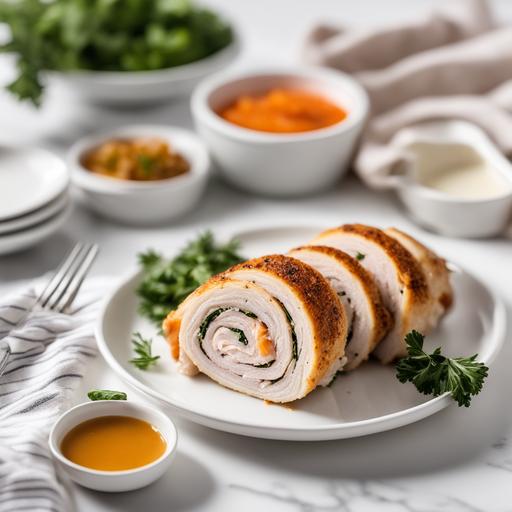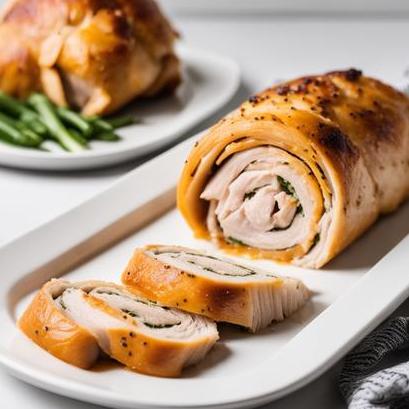[GUIDE] How Long To Cook A Turkey Roll In Oven

Cooking a turkey roll in the oven is a popular choice for holiday meals or special occasions. However, it’s essential to know the correct cooking time to ensure a perfect, juicy, and flavorful turkey roll. In this guide, we will explore the key factors that determine the cooking time for a turkey roll in the oven and provide step-by-step instructions to help you cook it to perfection.
Quick Answer: How Long To Cook A Turkey Roll In The Oven
The approximate cooking time for a turkey roll in the oven is 20 minutes per pound at an oven temperature of 325°F (163°C). However, it’s crucial to use a meat thermometer to check the internal temperature to ensure it reaches the safe minimum internal temperature of 165°F (74°C).
Key Takeaways
- The approximate cooking time for a turkey roll in the oven is 20 minutes per pound.
- The ideal oven temperature for cooking a turkey roll is 325°F (163°C).
- Use a meat thermometer to check the internal temperature and ensure it reaches 165°F (74°C).
- Let the turkey roll rest for at least 15 minutes before carving to allow the juices to redistribute.
The Science Of Cooking A Turkey Roll

Cooking a turkey roll is a delicate process that involves understanding the science behind heat transfer, internal temperature, and meat composition. Turkey meat consists of both lean muscle fibers and connective tissues. The heat from the oven denatures the proteins in the muscle fibers, allowing them to coagulate and retain moisture. Slow and even heat allows the connective tissues to break down slowly, resulting in a tender and succulent turkey roll.
Choosing A Turkey Roll
When choosing a turkey roll, opt for a quality boneless turkey breast that is free from additives or excessive sodium injections. Look for a turkey roll with even thickness to ensure uniform cooking. If possible, choose a turkey roll with the skin intact, as it adds flavor and helps retain moisture during cooking.
Preparing A Turkey Roll

Before cooking a turkey roll, it’s essential to properly prepare it to enhance its flavor and ensure even and safe cooking. Here are the steps to follow:
-
Thaw the Turkey Roll: If your turkey roll is frozen, thaw it in the refrigerator according to the package instructions. Thawing in the refrigerator is the safest method and helps maintain the quality of the meat.
-
Season the Turkey Roll: Season the turkey roll with your desired herbs, spices, and salt, ensuring the flavors penetrate the meat. You can use a pre-made seasoning blend or create your own.
-
Let the Turkey Roll Rest: Allow the seasoned turkey roll to sit at room temperature for about 30 minutes before cooking. This step allows the meat to come to a more even temperature, resulting in more even cooking.
Ideal Cooking Temperature For A Turkey Roll
The ideal oven temperature for cooking a turkey roll is 325°F (163°C). This temperature allows the turkey roll to cook evenly and retain moisture, resulting in a juicy and flavorful outcome. Cooking at too high a temperature can lead to overcooking the outside while the center remains undercooked.
Turkey Roll Cooking Time

The cooking time for a turkey roll depends on its weight. As a general rule, you should cook a turkey roll for approximately 20 minutes per pound. However, since every oven is different, it’s important to use a meat thermometer to check the internal temperature for doneness.
Cooking Techniques
There are various cooking techniques you can choose from when preparing your turkey roll. Here are two popular methods:
Roasting: Roasting is the most common method for cooking a turkey roll. Preheat the oven to 325°F (163°C) and place the turkey roll on a rack in a roasting pan. Cover the turkey roll loosely with foil to prevent excessive browning. Roast the turkey roll until it reaches an internal temperature of 165°F (74°C), typically about 20 minutes per pound.
Spatchcocking: Spatchcocking involves removing the backbone of the turkey roll, allowing it to cook more quickly and evenly. To spatchcock a turkey roll, use kitchen shears or a sharp knife to cut along both sides of the backbone and remove it. Flatten the turkey roll and follow the cooking time and temperature guidelines mentioned earlier.
Monitoring And Troubleshooting

Monitoring: It’s crucial to monitor the cooking process to prevent overcooking or undercooking. Use a meat thermometer to check the turkey roll’s internal temperature at different intervals during the cooking process.
Troubleshooting: If you notice that the turkey roll is browning too quickly on the outside, tent it with foil to prevent further browning. If the turkey roll is taking longer to cook than expected, make sure your oven temperature is accurate and adjust accordingly. Additionally, if the turkey roll is cooking unevenly, rotate the pan halfway through the cooking time for even browning.
Turkey Roll Cooking Instructions
Here are step-by-step instructions to cook a turkey roll in the oven:
-
Preheat the oven to 325°F (163°C).
-
Place the turkey roll on a rack in a roasting pan. If desired, lightly oil the rack to prevent sticking.
-
Cover the turkey roll loosely with foil. This helps retain moisture and prevent excessive browning.
-
Insert a meat thermometer into the thickest part of the turkey roll, ensuring it doesn’t touch the bone.
-
Place the turkey roll in the preheated oven and cook for approximately 20 minutes per pound or until it reaches an internal temperature of 165°F (74°C).
-
Once the turkey roll reaches the desired temperature, remove it from the oven.
-
Tent the turkey roll with foil and let it rest for at least 15 minutes before carving. This step allows the juices to redistribute and results in a moister turkey roll.
Variations

There are many ways to customize your turkey roll by adding different flavors and textures. Here are a few popular variations:
-
Stuffed Turkey Roll: Consider stuffing the turkey roll with your favorite stuffing mixture before cooking. Make sure the stuffing reaches an appropriate safe internal temperature.
-
Glazed Turkey Roll: Add a glaze mixture consisting of honey, mustard, and spices to brush over the turkey roll during the last 30 minutes of cooking. This adds a sweet and savory flavor to the turkey roll.
-
Herb-Crusted Turkey Roll: Create a crust by combining herbs such as rosemary, thyme, and sage with breadcrumbs or panko. Press this mixture onto the turkey roll before placing it in the oven for a flavorful, crispy exterior.
When Things Go Wrong
Sometimes, despite your best efforts, things may not go according to plan when cooking a turkey roll. Here are a couple of common issues and their solutions:
Undercooked Turkey Roll: If your turkey roll is undercooked, return it to the oven and continue cooking until it reaches the safe minimum internal temperature of 165°F (74°C). Make sure to check the temperature often to prevent overcooking.
Dry Turkey Roll: If your turkey roll turns out dry, it may have been overcooked. To salvage it, slice the turkey roll and serve it with a flavorful gravy or sauce to add moisture.
Serving A Turkey Roll

When carving and serving your turkey roll, follow these guidelines:
-
Use a sharp carving knife or an electric knife to carve the turkey roll. Begin by slicing against the grain to ensure tender slices.
-
Serve the sliced turkey roll on a platter, drizzled with some natural pan juices.
-
Accompany the turkey roll with your favorite side dishes, such as roasted vegetables, mashed potatoes, cranberry sauce, or gravy.
Best Practices For Turkey Roll Cooking
To ensure a successful and delicious turkey roll cooking experience, here are some best practices to keep in mind:
-
Plan Ahead: Make sure to plan your cooking time in advance, considering the thawing and resting time for the turkey roll.
-
Use a Meat Thermometer: Invest in a good-quality meat thermometer to accurately determine the turkey roll’s internal temperature. This ensures it reaches the safe minimum internal temperature of 165°F (74°C) without overcooking.
-
Let it Rest: Allowing the turkey roll to rest after cooking is crucial for juicy and flavorful meat. The resting time allows the juices to redistribute, resulting in a moister turkey roll.
-
Monitor and Adjust: Keep an eye on the cooking process and make adjustments if necessary. Use a meat thermometer and be prepared to adjust the oven temperature or cooking time accordingly.
-
Experiment with Flavors: Don’t be afraid to experiment with different herbs, spices, and glazes to enhance the flavor of your turkey roll.
Conclusion
Cooking a turkey roll in the oven requires precision, patience, and attention to detail. By following the guidelines provided in this article, you can confidently cook a turkey roll to perfection, resulting in a delicious and memorable meal for you and your loved ones. Remember to plan ahead, use a meat thermometer, and enjoy the process of creating a sumptuous turkey roll that will be the centerpiece of your next special occasion.
FAQS
What Is A Turkey Roll, And How Does It Differ From A Whole Turkey?
A turkey roll is a boneless turkey breast that is rolled and tied with kitchen twine to maintain its shape while roasting. It is much smaller than a whole turkey and has a more uniform shape, making it easier to cook evenly.
How Long Should I Cook A Turkey Roll In The Oven?
The cooking time for a turkey roll varies depending on its weight. As a general rule, you should roast a turkey roll for 20-25 minutes per pound at a temperature of 325 degrees Fahrenheit. Using a meat thermometer is the best way to ensure that your turkey roll is fully cooked; you should aim for an internal temperature of 165 degrees Fahrenheit in the thickest part of the roll.
What Are Some Tips For Making Sure My Turkey Roll Turns Out Moist And Flavorful?
Turkey rolls tend to dry out quickly, so it is important to baste them frequently with pan juices or butter. You can also inject the turkey roll with a flavorful marinade or apply a seasoning rub before cooking to add extra flavor and moisture. Letting the turkey rest for at least 15 minutes after cooking will also help to retain its juices.
Can I Stuff A Turkey Roll Like I Would A Whole Turkey?
It is not recommended to stuff a turkey roll because it is smaller and has a more uniform shape. This can make it difficult to properly cook the stuffing, and it may not be safe to eat. If you want to serve stuffing with your turkey roll, it is best to prepare it separately in a baking dish.
Are There Any Other Cooking Methods I Can Use For A Turkey Roll Besides Roasting It In The Oven?
Yes, you can also cook a turkey roll on the grill, in a slow cooker, or even in an Instant Pot. However, be sure to adjust your cooking time and temperature according to the instructions for your specific appliance, and always use a meat thermometer to ensure that the turkey is fully cooked.
Sources
About the Author Jenny
I'm Jenny, a housewife with an unwavering passion for food. My culinary journey began with my grandmother's kitchen, and it's now a full-fledged food blog. I've turned my love for cooking into a creative outlet, sharing recipes and stories with a global community of fellow food enthusiasts. It's proof that being a housewife can also mean pursuing your passions and savoring life's delectable moments.
